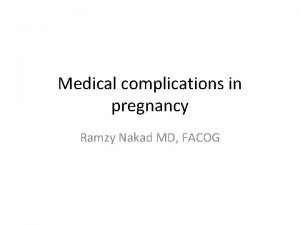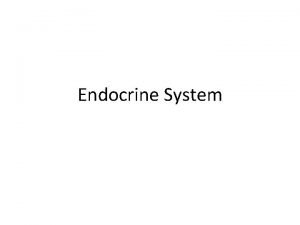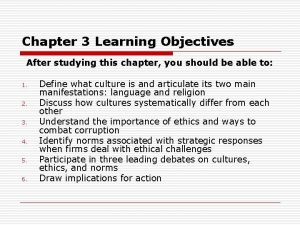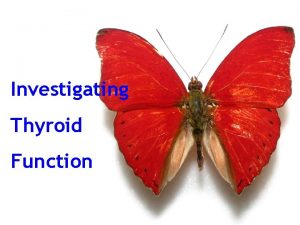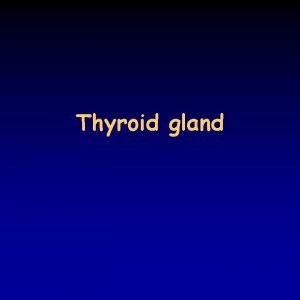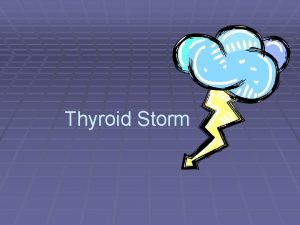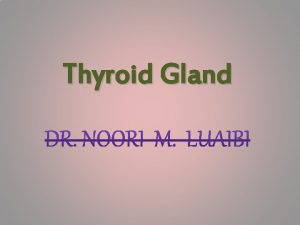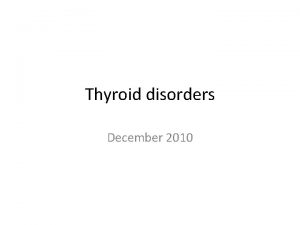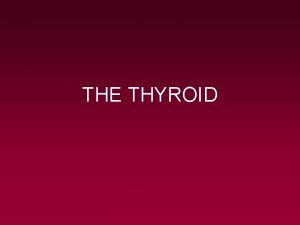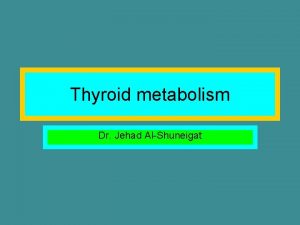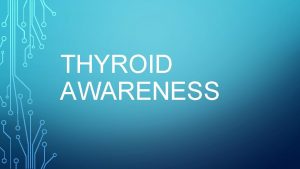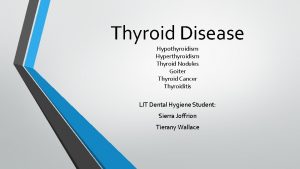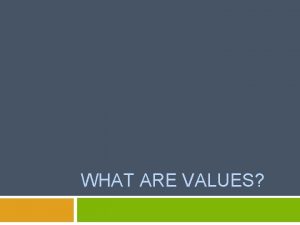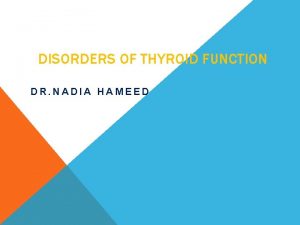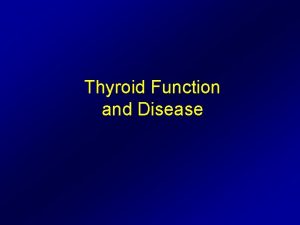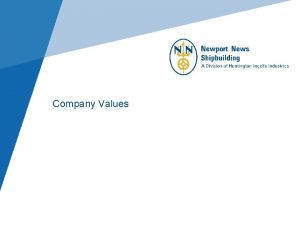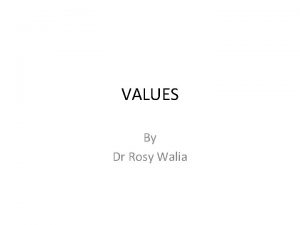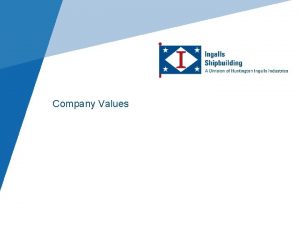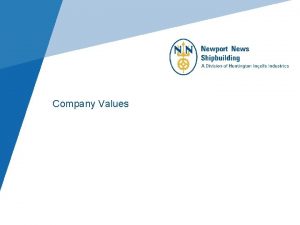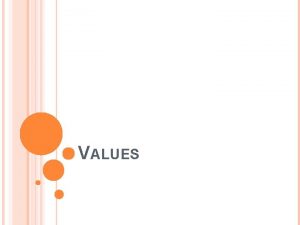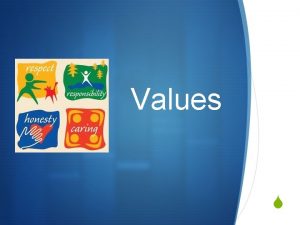M Tohidi 1 Reference Values for Thyroid Function






































- Slides: 38

M. Tohidi 1

Reference Values for Thyroid Function Tests & TPO-Ab in Iranian population Maryam Tohidi Associate professor of anatomical & clinical pathology Research Institute for Endocrine Sciences Shahid Beheshti University of Medical Sciences M. Tohidi 2

Agenda ü Introduction to reference value ü Reference values for TSH & FT 4 in Iranian adults ü Reference values for TPO-Ab in Iranian adults ü Trimester specific reference values for TSH & FT 4 I in Iranian pregnant women M. Tohidi 3

Reference value ü This concept was launched by Saris and Ralph Gra¨sbeck in a specific conference devoted to normal values during a Congress of Clinical Laboratory Medicine in 1969. ü The concept of normal values was scientifically flawed & needed a well defined nomenclature & recommended procedures in the field. History M. Tohidi 4

Reference values could be derived from many kinds of: ü individuals provided the selection criteria ü the state of health of individuals (including poor health) ü specimen collection Reference value ü analytical procedures M. Tohidi 5

Selection of reference individuals & population ü Purpose of ordered laboratory tests (diagnosis, epidemiological information & disease prevention) ü The principal purpose of medicine is to make or keep people well, to give them health and to help them maintain it. ü These goals justifies that you know the values of healthy persons. M. Tohidi 6

Determination of Reference values 1. Select a reference group representative of the population 2. Free of disease and conditions that might cause an “abnormal” result 3. Establish excluding criteria including factors that may impact the test 4. Screen and test reference group 5. Calculate reference values M. Tohidi 7

Types of reference values ü Na, reference value determined on a reference population; physiologically determined so it should be independent of region and ethnicity ü TSH, reference value determined by age, sex, ethnicity, geographic location, iodine intake ü CHOL. , reference value not relevant; level to treat determined by epidemiologic studies of risk M. Tohidi 8

TSH & FT 4 9

Reference limit thyroid function tests Thyroid stimulating hormone (TSH): ü A sensitive indicator of hypothalamo-pituitary-thyroid (HPT) axis integrity. ü The most common test used for evaluation of HPT axis function. ü Reciprocal log-linear relation with free thyroxine (FT 4). ü Thus the definition of TSH reference range is of critical importance for the diagnosis of thyroid dysfunction. M. Tohidi 10

Guideline of the National Academy of Clinical Biochemistry (NACB) for determination of TSH reference intervals ü 95% confidence limits of the log-transformed values of at least 120 rigorously screened normal euthyroid volunteers § No family history of thyroid dysfunction § No visible or palpable goiter § No detectable thyroid auto-antibodies § No medications (except estrogen) M. Tohidi 11

Subjects in TTS 5704 (≥ 20 yrs) Methods TSH & FT 4 assays: ECLIA (Roche Diagnostics) Intra- & inter-assay CV% : 1. 2 & 3. 5% 2199 TPO assay: ELISA (43. 3% M and 56. 7% F) Intra- & inter-assay CV% : 3. 9 & 4. 2 % ↓ Statistical analysis Normal-based methodology using fractional polynomial regression models Exclusion criteria § Known history of thyroid disease § Medicine such as levothyroxine, methimazole, carbimazole, amiodarone, lithium § Pregnancy or breast feeding § TSH<0. 1 m. U/l § TSH>10 m. U/l § Positive thyroid peroxidase antibody M. Tohidi

TSH 0. 30 – 5. 06 m. U/L FT 4 0. 91 – 1. 55 ng/d. L M. Tohidi

Comparison of TSH concentration between TPOAb negative & positive subjects Groups (No. ) 2. 5 centile 97. 5 centile TPO-negative (2199) 0. 32 5. 06 TPO- positive (260) 0. 38 8. 15 Mean±SD IQR Median TSH distribution of TPOAb positive individuals shifted to significantly higher TSH 1. 77± 1. 24 (0. 93 -2. 23) 1. 46 levels than TPOAb negative individuals. 3. 06± 2. 07 (1. 56 -4. 18) 2. 55 M. Tohidi 14

Serum FT 4 levels in the TPOAb negative subjects of different age groups ü Significant differences in medians of FT 4 between the age groups of 20 -29 & subjects ≥ 60 yr ü 1. 24 ng/dl vs 1. 18 ng/dl, respectively; p<0. 001 M. Tohidi 15

ü This finding is contrary to studies reporting that is not necessary to exclude thyroid antibodies positive cases for developing TSH distribution curves or calculating FT 4 reference limits. ü A guideline published by Baloch et al. stated that TSH reference limits should be established in disease free. ü Considering the gradual increase in TSH concentrations with age reported in other studies, we found no increase of this concentration in our elderly. M. Tohidi 16

Strength of this study ü Population based samples ü Measurement of FT 4 ü Measurement of TPO-Ab in all individuals M. Tohidi 17


Subjects 4174 (≥ 20 yrs) Methods Method of assay: TPO assay: ELISA (Accu. Bind™, Monobind, Costa Mesa, CA, USA) Intra- & inter-assay CV% : 2823 (1081 M & 1742 F) 3. 9 & 4. 2 % ↓ Exclusion criteria § Thyroid surgery § Taking thyroid hormones & antithyroid drugs § Abnormal thyroid function tests § Taking glucocorticoids § Pregnancy § Smoking § Outlier data Statistical analysis Exponential–normal (EN) model & modulus exponential– normal (MEN) M. Tohidi

Age specific serum TPOAb concentration (IU/m. L) and corresponding percentiles in 1081 males TPOAb Percentiles Age (years) 2. 5 th 20 -30 1. 27 1. 51 30 -40 1. 4 1. 66 40 -50 1. 58 1. 86 2. 27 3. 26 5. 15 8. 79 50 -60 1. 83 2. 13 2. 56 3. 59 5. 52 60 -70 2. 16 2. 49 2. 94 4. 00 70 -80 2. 64 2. 98 3. 45 All 1. 50 1. 81 2. 22 10 th 25 th 50 th 75 th 90 th 95 th 97. 5 th 22. 6 34. 51 23. 22 35. 07 15. 6 23. 3 34. 58 9. 1 15. 59 22. 71 32. 88 5. 91 9. 32 15. 2 21. 4 29. 96 4. 51 6. 33 9. 41 14. 41 19. 4 26. 00 3. 21 5. 70 8. 70 15. 29 22. 52 32. 80 Male: 4. 48 7. 95 14. 7 2. 04 2. 98 4. 8 8. 39 15. 28 1. 50 – 32. 80 IU/m. L 1. 86 2. 75

Age specific serum TPOAb concentration (IU/m. L) and corresponding percentiles in 1742 females Age (year) 2. 5 th 20 -30 1. 38 30 -40 TPOAb Percentiles 5 th 10 th 1. 60 1. 92 25 th 50 th 75 th 90 th 97. 5 th 24. 47 35. 13 1. 51 Female: 2. 77 4. 75 9. 06 16. 59 1. 741. 55 – 35. 04 IU/m. L 2. 08 2. 97 5. 02 9. 40 16. 92 95 th 24. 7 35. 12 40 -50 1. 65 1. 89 2. 25 3. 18 5. 30 9. 75 17. 27 24. 94 35. 10 50 -60 1. 80 2. 06 2. 44 3. 41 5. 59 10. 12 17. 62 25. 17 35. 09 60 -70 1. 96 2. 24 2. 64 3. 65 5. 90 10. 49 17. 97 25. 41 35. 08 70 -80 2. 15 2. 43 2. 86 3. 91 6. 23 10. 89 18. 34 25. 66 35. 06 All 1. 55 1. 79 2. 15 3. 08 5. 18 9. 61 17. 13 24. 84 35. 04

Thyroid. 2016 Mar; 26(3): 458 -65. doi: 10. 1089/thy. 2015. 0276. Sex- and Age-Specific Reference Values and Cutoff Points for TPOAb: Tehran Thyroid Study. Amouzegar A, Bakhtiyari M, Mansournia MA, Etemadi A, Mehran L, Tohidi M, Azizi F. PMID: 26650261 22

Reference values in Pregnancy 23

RECOMMENDATION 1 Trimester-specific reference ranges for TSH, as defined in populations with optimal iodine intake, should be applied. Level B-USPSTF M. Tohidi 24

Recommendations of ATA 2011 and the ES 2012 guidelines • The normal thyrotropin reference range should be: • 0. 1 - 2. 5 m. IU/L, in the first trimesters of pregnancy • 0. 2 -3. 0 m. IU/L, in the second trimesters • 0. 3 -3. 5 m. IU/L in the third trimesters ü Probably not valid worldwide (variable in different geographic region and ethnic origin) M. Tohidi


Justification for Population based and Trimester specific Reference rang for TSH and FT 4 ü The normal reference ranges of TSH and FT 4 differ markedly during pregnancy ü Significantly different in each of the three trimesters ü Variable values in different geographic region and ethnic origin


ü Use of the ATA 2011 and the ES 2012 guidelines would have resulted in 27. 8% of pregnant Chinese women being diagnosed as having subclinical hypothyroidism versus 4% if the ethnic specific reference range had been used • J Clin Endocrinol Metab 2014; 99: 73 -9

Methods Subjects 466 Tehranian preganant women Assay methods: TSH: IRMA T 4 & T 3: RIA All intra-assay CV% < 3. 9% Inter-assay CV%: 7. 1% Statistical analysis 5 th and 95 th percentiles using the bootstrap technique Exclusion criteria § Preexisting thyroid disorders, nodules & high thyroid volume § Taking medications affecting thyroid function § Thyroid autoantibody positivity § Not available in all trimesters or lost to follow-up § Low urinary iodine level (<150 �� g/L in two out of 3 in the first trimester) § Family history of thyroid diseases

First trimester TSH: 0. 2 – 3. 9 m. U/L Second trimester TSH: 0. 5 – 4. 1 m. U/L Third trimester TSH: 0. 6 – 4. 1 m. U/L



Trends of reference intervals during three trimesters of pregnancy for FT 4 I First trimester FT 4 I: 8. 5 -19 Second trimester FT 4 I: 9. 7 -21 Third trimester FT 4 I: 8. 7 -20. 4

Local versus international recommended TSH references in a iodine sufficient region Local versus international recommended TSH references in the assessment of thyroid function during pregnancy. Amouzegar A, et al. Hormone Metab Res 2014; 46: 206

Conclusions ü The reference value is one important issue in laboratory medicine. ü Reference ranges for thyroid function tests need to be derived from national databases. ü Result of TTS is in contradiction to age & sex specific TSH reference ranges for diagnosis & monitoring of patients. M. Tohidi 36

ü These published trimester specific reference values of thyroid hormones can be used for Iranian pregnant women in order to accurately detect thyroid dysfunction during pregnancy. ü Using arbitrary cutoff values for TSH instead of population-specific reference intervals may inappropriately increase the rate of thyroid function abnormality (subclinical hypothyroidism). ü Because of problems with accuracy and reliability of most FT 4 immunoassay methods during pregnancy, and until standard methods become more widely available for accurate measurement of FT 4, FT 4 I could be used for an accurate estimation of FT 4 during pregnancy. M. Tohidi 37

 Hypothyroid symptoms
Hypothyroid symptoms Signs of thyroid issues
Signs of thyroid issues Reference node and non reference node
Reference node and non reference node Reference node and non reference node
Reference node and non reference node Western values vs eastern values
Western values vs eastern values Bruce maglino workplace values
Bruce maglino workplace values Instrumental values
Instrumental values A bit can only have the value of 0 or 1
A bit can only have the value of 0 or 1 Human values.
Human values. Kontinuitetshantering i praktiken
Kontinuitetshantering i praktiken Typiska drag för en novell
Typiska drag för en novell Tack för att ni lyssnade bild
Tack för att ni lyssnade bild Vad står k.r.å.k.a.n för
Vad står k.r.å.k.a.n för Varför kallas perioden 1918-1939 för mellankrigstiden
Varför kallas perioden 1918-1939 för mellankrigstiden En lathund för arbete med kontinuitetshantering
En lathund för arbete med kontinuitetshantering Kassaregister ideell förening
Kassaregister ideell förening Personlig tidbok fylla i
Personlig tidbok fylla i A gastrica
A gastrica Vad är densitet
Vad är densitet Datorkunskap för nybörjare
Datorkunskap för nybörjare Tack för att ni lyssnade bild
Tack för att ni lyssnade bild Mall för debattartikel
Mall för debattartikel Delegerande ledarskap
Delegerande ledarskap Nyckelkompetenser för livslångt lärande
Nyckelkompetenser för livslångt lärande Påbyggnader för flakfordon
Påbyggnader för flakfordon Vätsketryck formel
Vätsketryck formel Offentlig förvaltning
Offentlig förvaltning Kyssande vind analys
Kyssande vind analys Presentera för publik crossboss
Presentera för publik crossboss Argument för teckenspråk som minoritetsspråk
Argument för teckenspråk som minoritetsspråk Bat mitza
Bat mitza Klassificeringsstruktur för kommunala verksamheter
Klassificeringsstruktur för kommunala verksamheter Mjälthilus
Mjälthilus Bästa kameran för astrofoto
Bästa kameran för astrofoto Cks
Cks Lågenergihus nyproduktion
Lågenergihus nyproduktion Mat för unga idrottare
Mat för unga idrottare Verktyg för automatisering av utbetalningar
Verktyg för automatisering av utbetalningar Rutin för avvikelsehantering
Rutin för avvikelsehantering
